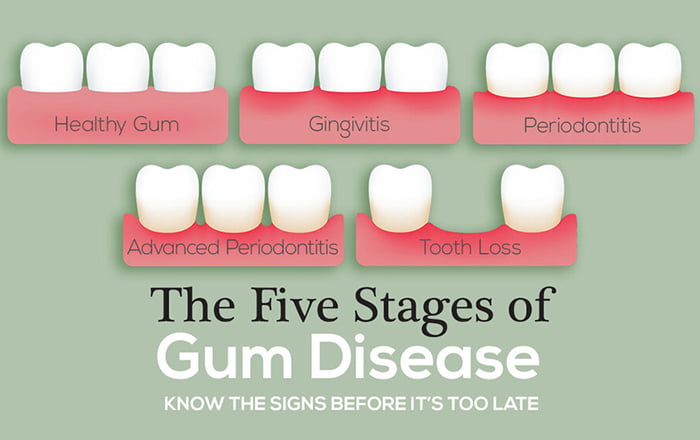Periodontal disease is a serious infection of the gums that can lead to tooth loss. It is also linked to other health problems such as heart disease, stroke, and diabetes. Taking care of your teeth and gums is important for your overall health.
Periodontal disease is caused by plaque, a sticky film of bacteria that forms on your teeth. Plaque produces toxins that damage the gums and bone around the teeth. If plaque is not removed, it can harden into calculus (tartar). Calculus can only be removed by a dentist or dental hygienist.
Patients with good oral health should brush and floss at least twice a day, but if you are vigilant about your oral hygiene, plaque buildup is inevitable.
If you have periodontal disease, do not wait. You need to see a dentist.

What is gum disease and what are the different types?
Gum disease is the leading cause of tooth loss in adults. It is a serious infection of the gums that can damage the bone and supporting tissues of the teeth. Gum disease is caused by plaque, a sticky film of food debris, bacteria, and saliva. Plaque forms on teeth when they are not cleaned properly. If plaque is not removed, it can harden into tartar, which is much harder to remove.
There are two types of gum disease: gingivitis and periodontitis. Gingivitis is the early stage of gum disease and usually does not cause permanent damage. Periodontitis is more advanced and can destroy the bone and connective tissue that support the teeth. If left untreated, periodontitis can lead to tooth loss.

Scaling and Root Planing
Scaling and root planing, also known as deep cleanings, is a non-surgical procedure used to treat periodontitis. The goal of the procedure is to clean the teeth and remove any bacteria or tartar buildup. Scaling and root planing can be done in a dental office or at home with special scaling tools.
The first step in scaling and root planing is to remove any plaque or tartar from the teeth. This is done with a scaler, which is a small, hand-held tool that has a metal tip. The scaler is placed against the tooth and moved back and forth to loosen the plaque or tartar. Once the scaler has removed all of the plaque or tartar, it’s time to move on to the next step: root planing.
Root planing is essentially the same thing as scaling, except that it’s done with a tool called an explorer. The explorer has a flat, rubber tip at one end, and this is used to scrape away any plaque or tartar from the surface of the tooth. The rubber tip is also used to clean deep below the gum line, beyond where the scaler could go. The purpose of removing plaque and tartar from the teeth is to remove sources of infection that might cause problems for the gums.
Periodontal Maintenance
Periodontal (perio) maintenance is a type of dental cleaning that is performed on patients who previously had periodontitis and was treated with scaling and root planing. This cleaning is done to remove tartar and plaque from the teeth, as well as to smooth out any rough spots on the tooth surface. Periodontal maintenance is typically done every three to four months, and may be more often if the patient has severe gum disease.
Pocket depths and your periodontal status are clinically assessed during a periodontal maintenance appointment. Deeper periodontal maintenance cleans your teeth down a little closer to your gumline since a previous history of gum disease puts you at a higher risk for plaque and tartar accumulation.
Prophylaxis
Prophylaxis (prophy), also known as regular cleanings, is a preventative measure taken against gingivitis. It is a deep cleaning that removes tartar and plaque from teeth, both above and below the gum line. Prophy is usually done every six months, but may be more often if you have a history of gum disease.
Which gum disease treatment is right for you?
If you have been diagnosed with periodontal disease, your dentist may recommend one of several types of treatment. The type of treatment recommended will depend on the severity of your disease.
The first line of defense against periodontal disease is a good dental hygiene routine including brushing twice a day, flossing daily, and using an antibacterial mouthwash. If your disease is in the early stages, this may be all the treatment you need.
If your disease is more advanced, your dentist may recommend scaling and root planing. This is a deep cleaning procedure that removes tartar and bacteria from below the gumline. You may need to have this procedure done more than once.
Periodontal disease is a serious infection of the gums that can lead to tooth loss. left untreated, it can also cause other health problems. While regular professional cleanings (known as prophylaxis or “prophy”) are important for keeping the disease under control, they are not enough to maintain optimal oral health.
Dental patients with periodontal disease need to take an active role in their own oral care, in addition to getting regular prophy appointments. This means brushing and flossing every day, using an antimicrobial mouthrinse, and eating a healthy diet. It also means avoiding tobacco use, which can make the disease worse.
Working together, patients and their dental team can keep periodontal disease under control and improve overall oral health.
See Dentist For Life
Looking for an experienced and trusted dentist in Marysville, Ohio? Look no further than Dentist For Life! We provide comprehensive dental care for patients of all ages. We take a wide variety of insurance plans and are currently accepting new patients. You can reach us at (937) 707-1111 or schedule your appointment online here.



